When we look at the Hisense E7NQ PRO in everyday use, it is immediately clear that this television is designed for a wide audience. Although the image doesn't blow you away at first glance, it improves significantly after proper calibration. The colours appear more natural, and a brightness of around 500 cd/m² makes it comfortable to watch even in a sunny living room. The wide viewing angles offered by the IPS panel are an added bonus – we no longer have to fight for the best spot on the sofa. Dolby Vision can enhance the overall experience, and in SDR mode, the TV delivers a pleasant picture. Sports and gaming fans will find even more reasons to be satisfied. The high refresh rate (144 Hz) guarantees smooth ball movements on the field, and low latency, VRR, ALLM, and compatibility with G-Sync and Dolby Vision in games cater to those who value responsiveness and immersive gaming experiences. Because of all this, E7NQ PRO has become an interesting option for PC gamers. The VIDAA system works smoothly with plenty of apps, although it lacks typical music platforms like Spotify or Tidal. However, one can count on recording, AirPlay, mirroring, and decent compatibility with wireless devices. Admittedly, there are some shortcomings and flaws – especially concerning subtitle support from USB or perfect brightness and contrast management, and the absence of HGIG may disappoint the most demanding gamers. When we gather all the impressions and experiences, E7NQ PRO emerges as a device that works well in many situations. It has its advantages – including wide viewing angles, pleasant picture after calibration, plenty of additional features, and excellent motion fluidity in sports or games. At the same time, it should be remembered that this is not a television intended for those looking for perfect experiences during evening screenings in complete darkness. In low light, the shortcomings in contrast and black levels become more apparent, so we suggest that those planning mainly evening screenings look for alternatives among competitors. Nevertheless, as a universal solution for everyday use – from watching TV in a bright living room to playing console and computer games – E7NQ PRO performs really well.
- Matching (Score)
- Our verdict
- TV appearance
- Where to buy
- Contrast and black detail
- HDR effect quality
- Factory color reproduction
- Color reproduction after calibration
- Smoothness of tonal transitions
- Image scaling and smoothness of tonal transitions
- Blur and motion smoothness
- Console compatibility and gaming features
- Input lag
- Compatibility with PC
- Viewing angles
- TV efficiency during daytime
- Details about the matrix
- TV features
- Apps
- Playing files from USB
- Sound
Hisense E7NQ PRO vs LG OLED G5
Direct compare
Check the best price offer:
LG OLED G5G54 / G51 / G55 / LW / LS

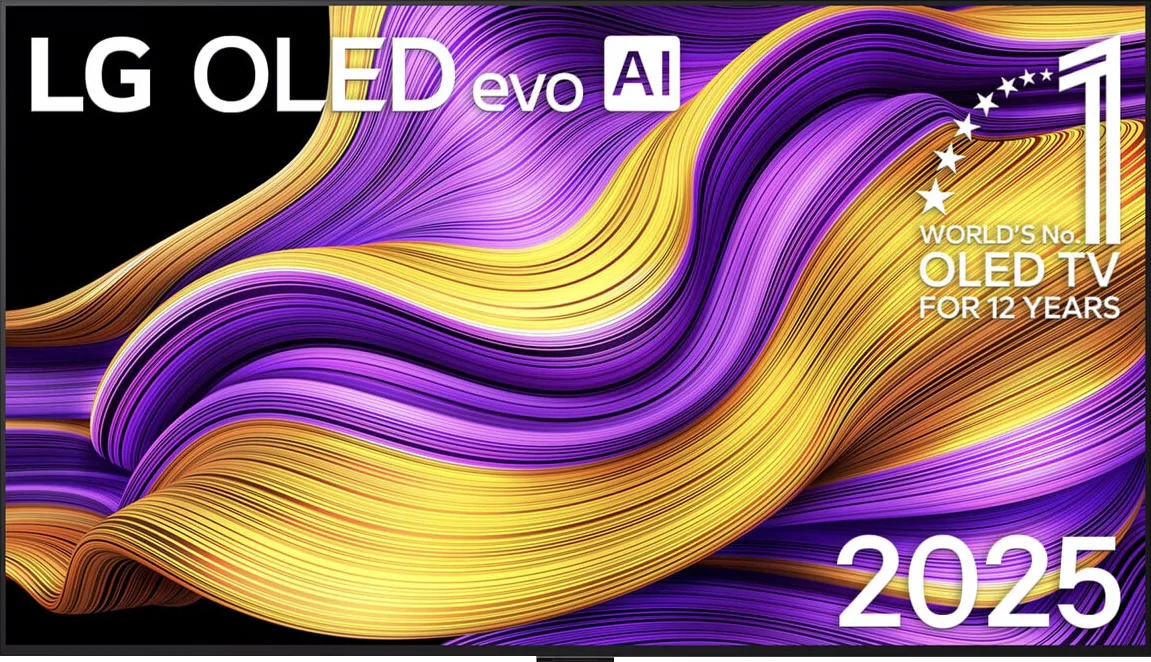
Panel type: LCD IPS
Resolution: 3840x2160
System: VIDAA
Model year: 2024
Complete the survey to find out the result

Panel type: WRGB OLED
Resolution: 3840x2160
System: WebOS
Model year: 2025
Complete the survey to find out the result

Overall rating
7.0
8.9
Movies and series in UHD quality
6.4
9.2
Classic TV, YouTube
6.3
9.2
Sports broadcasts (TV and apps)
6.6
9.0
Gaming on console
8.0
9.6
TV as a computer monitor
7.6
8.8
Watching in bright light
6.2
8.0
Utility functions
8.9
8.5
Apps
7.7
9.1
Sound quality
7.0
8.7
Complete the survey to find out what fits your preferences
Advantages
Wide viewing angles thanks to the IPS matrix
Good color potential after calibration
High refresh rate (144 Hz), VRR, ALLM, and G-Sync for gamers
Support for Dolby Vision
A considerable number of additional features (recording, AirPlay, mirroring)
Support for major audio formats (Dolby Atmos, DTS:X)
Relatively low input lag
Amazing black and contrast
Reference color reproduction after calibration
Very high brightness in HDR content
Outstanding cooperation with consoles and computers
Great motion fluidity - OLED panel 165Hz
Many features for gamers: VRR, ALLM, HGIG, low input lag
Excellent WebOS operating system with many applications
Superb handling thanks to the Magic remote with "cursor" function
Disadvantages
Average contrast and black
Problems with subtitle playback from USB
No support for HGIG
Brightness management issues in HDR in some scenes
Unavailability of some popular music apps (Spotify, Tidal)
No support for DTS audio format
Worse (though still good) viewing angles than the predecessor G4
Different versions of the remote in derivative models – hard to predict which version we will get
Our verdict
The LG G5 is a television that not only continues but also expands on what we loved about previous models in the G series. Instead of taking the beaten path, LG opted for a new Tandem OLED panel – and it was a stroke of genius. Picture brightness? Simply, F E N O M E N A L. HDR effect? Close to reference. Colors after calibration? Nearly perfect. Motion smoothness, low latency, and gaming features? At an absolutely top level. The G5 performs well in movies and games, day and night, whether with a decoder, console, PC, or just the remote. Of course – this is not a product without flaws. It's a pity that DTS support is lacking, the viewing angles have worsened compared to its predecessor, and the remote may vary depending on the version. But when we look at the overall picture, it's hard not to feel that this is one of the best OLED televisions available on the market, and perhaps even the best. Definitely, when it comes to its versatility and picture quality without having to reach for extremely expensive models from competitors. If you're looking for a television for everything – for cinema, gaming, a bright living room, streaming content, or connecting a computer – the LG G5 is a device that simply delivers on every front without compromise.
TV appearance




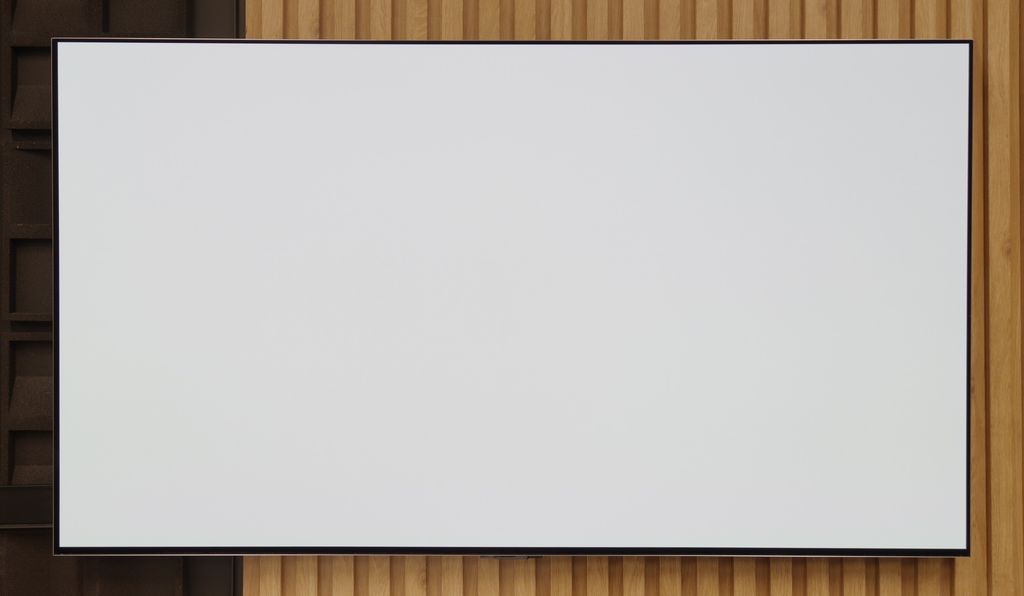
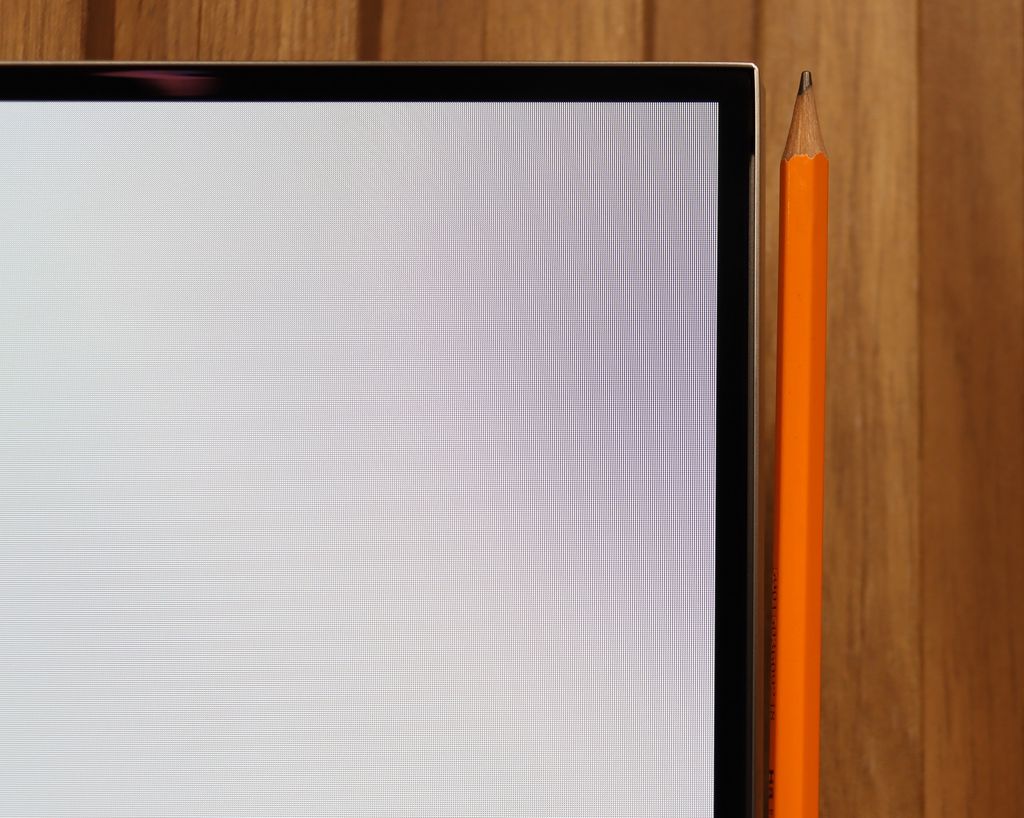
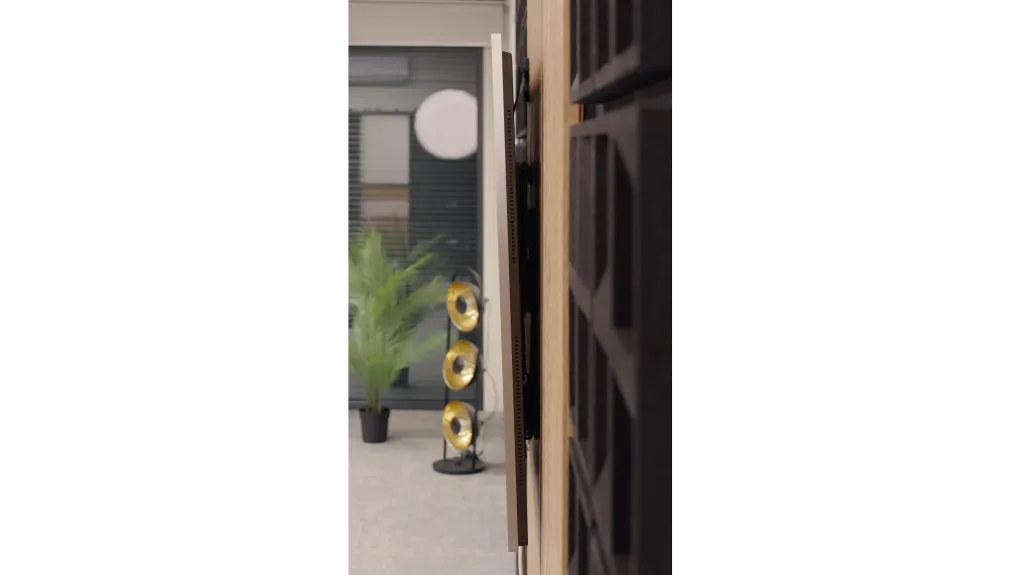
Contrast and black detail
5/10
10/10
Local dimming function: Yes, number of zones: 32 (4 x 8)
Contrast:

Result
7,850:1

Result
4,150:1

Result
4,400:1

Result
2,500:1

Result
1,550:1

Result
∞:1

Result
∞:1

Result
∞:1

Result
∞:1

Result
∞:1
Halo effect and black detail visibility:

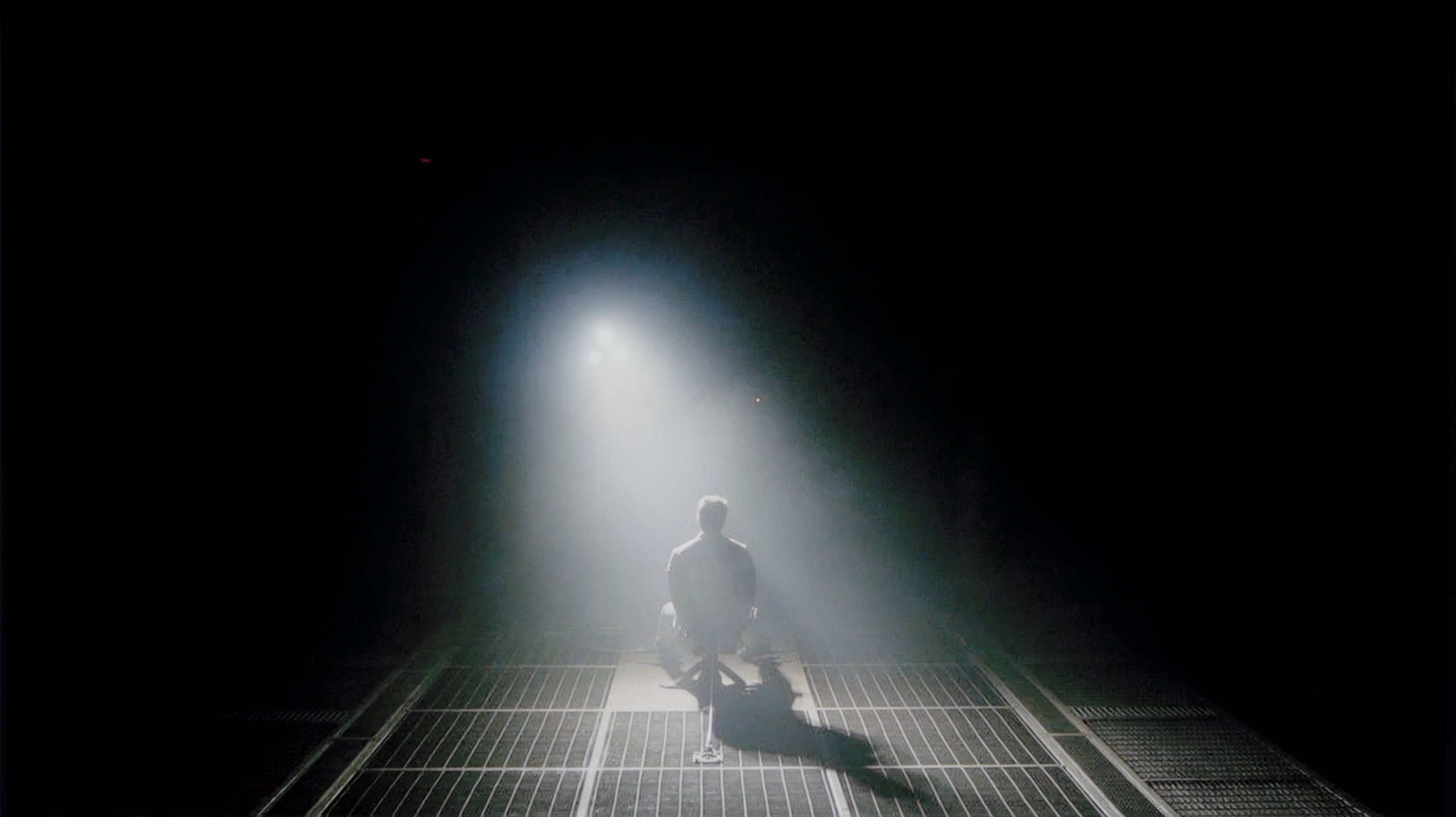
The tested Hisense E7NQ PRO in the 65-inch version uses an IPS panel, which unfortunately is not known for high contrast. As a result, blacks appear slightly "washed out" and occasionally take on a silvery hue, which is clearly visible in our photos. The manufacturer addressed this by equipping the TV with local dimming functionality. Unfortunately, in this 65-inch model, we only have 32 zones available, which, although it helps a little, is not enough to achieve truly impressive results, especially since the panel itself cannot provide a high-depth deep black. During testing, we observed highly varied results. In optimal conditions, we managed to reach around 7800:1, which can be considered decent, but in more challenging scenes, the contrast dropped to around 2000:1. Such values are at best average and do not befit a TV in this price range. Ultimately, although local dimming somewhat salvages the situation, there is a lack of truly deep, inky blacks and contrast that would leave a greater impression on us.
LG G5, as befitting an OLED television, impresses with its contrast and black quality. In scenes with a lot of dark areas, the screen looks almost perfect, offering deep, absolute black and infinite contrast – an effect that still cannot be achieved on any LCD television. The new Tandem OLED panel does not introduce any negative changes compared to previous generations – blacks are perfect regardless of the content. Watching scenes from movies like The Revenant or Oblivion, you can clearly see the excellent separation of lights, without any blooming effect or brightening of dark parts. In this category, the LG G5 deserves the highest rating.
HDR effect quality
5.1/10
9.1/10
Luminance measurements in HDR:

Result
408 nit

Result
299 nit

Result
446 nit

Result
215 nit

Result
527 nit

Result
2346 nit

Result
2353 nit

Result
2399 nit

Result
2353 nit

Result
2012 nit
Scene from the movie “Pan” (about 2800 nits)


Scene from the movie “Billy Lynn” (about 1100 nits)


Static HDR10


Dynamic: Dolby Vision
Dynamic: Dolby Vision


HDR luminance chart:
LG OLED G5
HDR luminance
Luminance of RGB colors
Hisense E7NQ PRO
HDR luminance
Based on the luminance chart, which indicates around 550 nits, it can be considered that Hisense E7NQ PRO theoretically has the potential to somewhat "enchant" us with its HDR image. While testing various scenes, we noticed that the TV continually tries to balance maintaining adequate brightness and preserving the deepest blacks. In favourable conditions – for instance, during a scene from "The Meg," where the screen is flooded with bright light – this brightness impresses. At such moments, we feel that HDR actually adds that "something" to the image. Unfortunately, when more challenging shots appear on the screen with small, bright elements against a dark background, the situation looks much worse. The brightness then drops to 200-300 nits, too little to distinguish HDR from regular SDR.
It's clear that the TV is trying, but hardware limitations – primarily the small number of local dimming zones – prevent it from fully spreading its wings. The result can therefore be quite uneven and just as average as in the contrast tests. However, it deserves credit for the impressive coverage of the DCI-P3 colour gamut at 97%. This allows the TV to showcase a wide range of colours, which, in the right scenes, can give us at least a taste of the true HDR effect. It’s a pity that the overall experience isn’t complemented by better brightness and contrast.
LG G5 with the new Tandem OLED panel brings the biggest change specifically in terms of the brightness of the television. And it’s quite impressive. This is truly an astronomically bright OLED. In every tested scene – whether it’s point lights or full-screen whites from the movie The Meg – the brightness on the G5 exceeded 2000 nits. Just a year ago, such values on an OLED were simply unimaginable. And here we are – the G5 comes close, and at times even surpasses the best Mini-LEDs on the market. A new feature of the Tandem OLED panel is the expanded color gamut coverage – and here the LG G5 performs almost perfectly. DCI-P3 achieves a full 100%, while BT.2020 maintains around 83%. These are some of the highest values currently available on the market – it’s hard to find any other television that comes close to such results, unless we are talking about the best displays with QD-OLED panels. The G5 has nearly reference-quality HDR – both in terms of brightness and color saturation. This is an OLED that can truly shine – and not just figuratively.
Factory color reproduction
5/10
7.8/10


Factory Mode
After calibration


Factory Mode
After calibration
When we took our copy of Hisense E7NQ PRO out of the box, we immediately started checking the available picture modes. Among them, the Filmmaker mode seemed the most promising, although it was not without flaws. With standard SDR content, we noticed a clear tendency for an excessive boost in red, which caused the image to appear unnaturally warm. This is particularly evident in the comparison photo included below. On the other hand, when we switched to HDR content, the situation went in the opposite direction. This time blue was dominant, and red was scarce, giving a cool effect, at times even a somewhat "store-like" impression — although not as drastic as in those modes that are actually intended for displaying in exhibitions. As a result, in our colour reproduction tests, these imbalances in colour balance led to significant errors.
Additionally, the TV had issues with rendering brightness characteristics. At lower resolutions, it clearly brightened the darkest elements of the image, and with HDR content, the brightness curve (eotf) did not want to align as it should. Initially, the TV excessively darkened the smallest details and then overly brightened larger areas. Fortunately, the E7NQ PRO provides us with plenty of calibration tools, so knowing the potential, we decided to take matters into our own hands and try to set it up to eliminate these issues.
Our test unit LG G5 struggled with some issues in the factory Filmmaker mode. And while the image might have seemed fine to most people, we knew that this TV was capable of much more. This mode had a clear excess blue tint in the white balance, resulting in a strong cooling of the image – particularly in HDR modes, where there was also a lack of red. The picture seemed cold, and its sharpness was artificially boosted and unnatural. Another significant issue was the brightness characteristic. In SDR content, the situation wasn't the worst, aside from a slight dimming of the entire image. However, it performed much worse in HDR materials – due to improper brightness management, the smallest details could completely disappear from the image, and larger, bright elements appeared overexposed and lacking gradation. Luckily, the G5 supports calibration using 3D LUT (a tool for professionals to calibrate colors), so we decided to take advantage of its professional background and see what it was really capable of. Because while it wasn't terrible even before calibration, the potential of this TV definitely deserved more.
Color reproduction after calibration
7.1/10
9.8/10




Thanks to the tools available in E7NQ PRO, we managed to squeeze a quite decent image out of it, especially in the case of lower-quality content. After fine-tuning the white balance of the SDR materials, the colours look much more natural, and what we see on the screen seems closer to the vision the manufacturer intended to present. Additionally, we improved the brightness characteristic (Gamma), causing the TV to no longer have a tendency to over-brighten, and everything looks significantly better than before our intervention.
In HDR materials, we also managed to achieve some results, although it is not as rosy here. Indeed, the white balance has approached an acceptable level, but the problem lies elsewhere. It concerns the EOTF curve, which is how the TV manages the brightness and tonality of the image. At first glance, it might seem that the biggest issue pertains only to the mid-tones of the image, which are overly illuminated. However, after more detailed testing and enabling filters to display the EOTF curve, it is evident that the receiver tends to brighten the entire screen. This appears to be a limitation arising from the small number of local dimming zones and generally modest brightness management capabilities. Such hardware limitations are simply insurmountable. After our calibration, however, the image is noticeably better than at the start. One just needs to be aware that in terms of contrast and brightness management, this model has its limits, which even good calibration cannot fully overcome.
After completing the calibration process using professional tools, we can confidently state that the LG G5 offers nearly reference-quality image. Most of the errors related to white balance and the ColorChecker test are below the value of 2, which is a phenomenal result, practically imperceptible to the human eye. And while one could still criticize that in HDR films the television tends to slightly dim the smallest elements of the image, in practice, this does not negatively affect the overall impression. Hats off to LG, because once again they provide the user with enormous possibilities for adjusting their display – and this, combined with very good parameters of the panel itself, results in an image that is truly hard to surpass.
Smoothness of tonal transitions
9.2/10
8.5/10












We must honestly admit that the smoothness of tonal transitions in this television is among the very best we have had the opportunity to test in 2024. Even in really demanding scenes, we hardly notice any noticeable "steps" between colors. Yes, with a keen eye, one can find minor shortcomings, but that is almost on a microscopic level. You really need to have a very "alert" eye to catch them. This, in turn, allows you to focus on the story and visual experiences while watching even the most complicated shots in a full range of colors, without the irritating, artificial effect of posterization.
The smoothness of tonal transitions in the LG G5 is a clear step forward compared to last year's model. Not only has the brightness improved, but also the way colors blend, which the G4 sometimes struggled with. In the vast majority of scenes, the G5 has no issues with tonal transitions – there is no typical banding associated with WOLED technology, nor ugly breaks between colors. Of course, in very dark areas of the image and with shades of gray, minor imperfections can still be noticed, but these are things that the average viewer wouldn't even register. In short – it's really good.
Image scaling and smoothness of tonal transitions
6/10
8.7/10
Smooth transition function

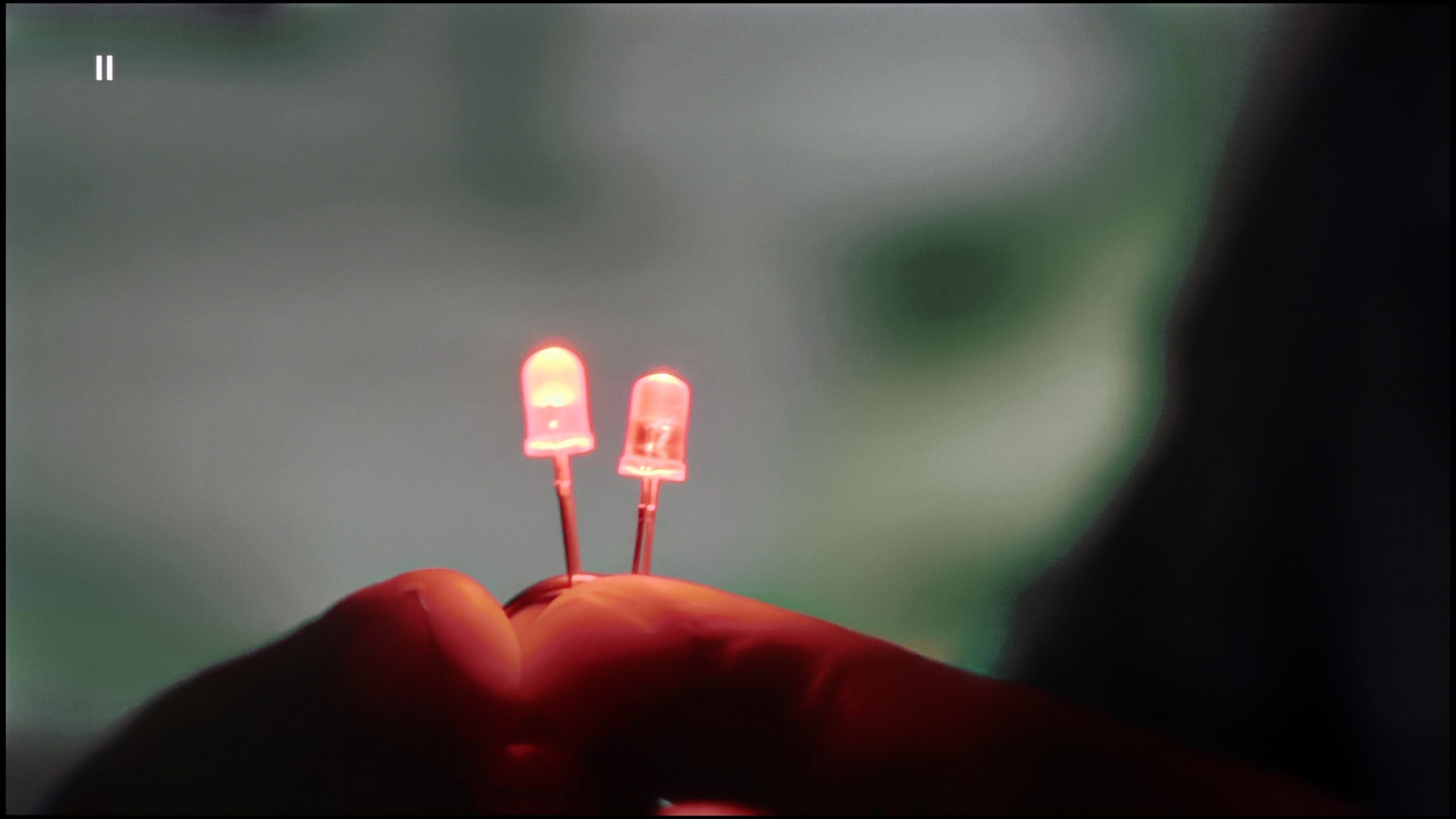
Image without overscan on the SD signal


Unfortunately, the "smooth and gradient image" feature in Hisense E7NQ PRO does not impress when it comes to smoothing tonal transitions in lower-quality materials. At the lowest setting, the change is hard to notice—it's more of a cosmetic improvement. Switching to "Medium" mode already provides a noticeable effect, but it still isn't anything special. In addition, the television starts to excessively interfere with other image elements, which can look unnatural.
Image scaling is also rather average. On the test screen, where a portrait of a model and text are displayed, slightly jagged edges can be seen, which makes the overall presentation less smooth and aesthetically pleasing than we would expect in this class of device. It's simply hard to speak of truly effective enhancement of lower resolution quality here.
Upscaling and digital image processing in the LG G5 perform very well. The television handles lower quality content exceptionally, especially when the "Smooth Gradation" feature is set to a low level. In this mode, it effectively removes unwanted artifacts and issues with visible tonal transitions. It may also slightly smooth out some desired details, such as the subtle texture of clothing or skin, but importantly – it does not remove film grain, so it’s hard to say there’s a serious compromise here. It’s one of those options that’s definitely worth enabling.
The G5 also does well with upscaling, which is improving the quality of older materials. The test image with the model looked really solid – slight edging was visible, but that’s an effect that can’t be completely avoided. Additionally, there were no issues with overscan, which – contrary to appearances – is not obvious, even in 2025.
Blur and motion smoothness
7/10
9/10

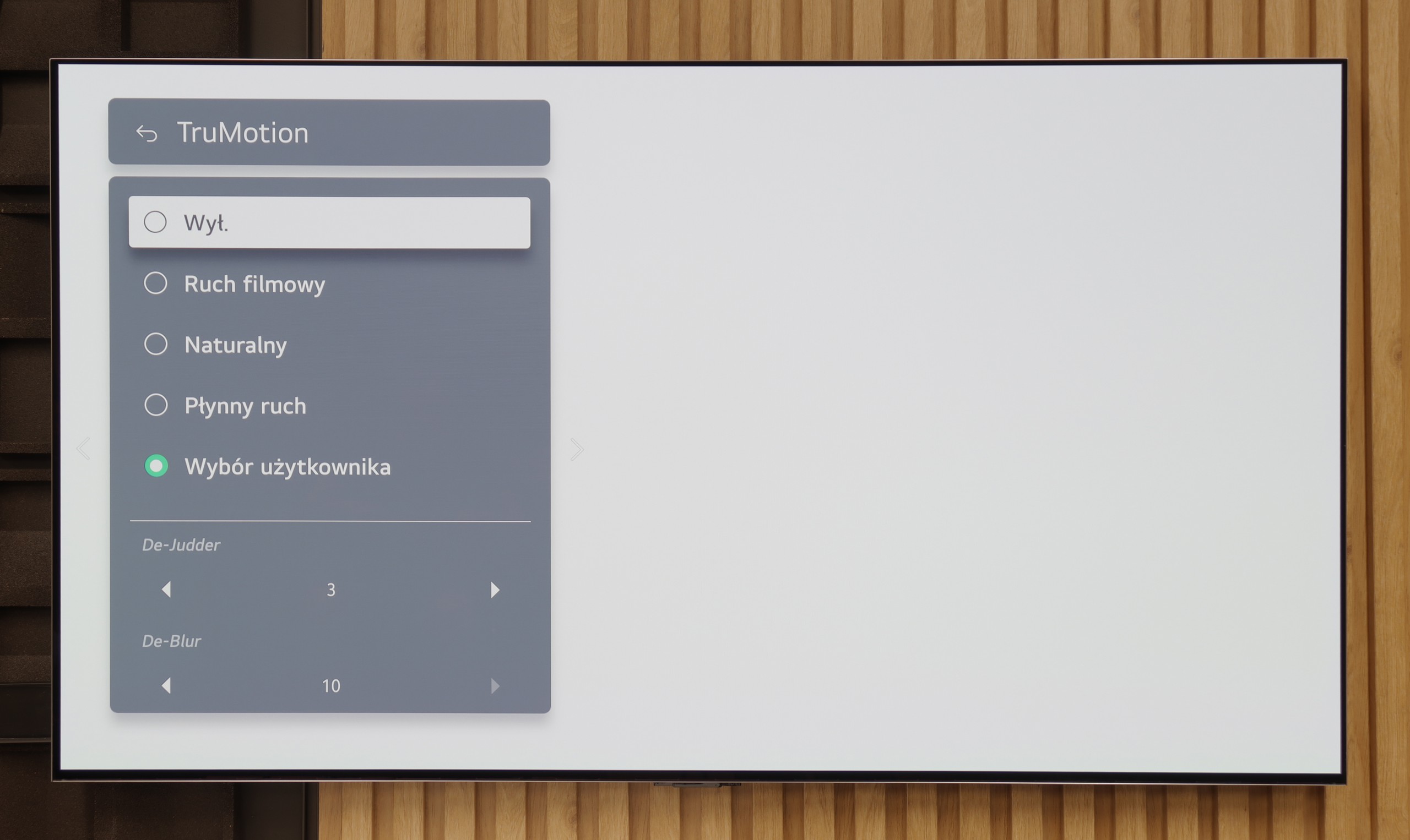
Blur (native resolution, maximum refresh rate):






Blur (BFI function enabled):
Image flickers in this mode



Smużenie ():
Smużenie (4K 165Hz):



Thanks to its 144 Hz panel, the E7NQ PRO performs excellently with almost every type of content. Whether we are watching fast-paced matches, dynamic games, or action movies, the fluidity of motion leaves a good impression. For movies, the manufacturer has equipped the TV with two key tools: "motion blur reduction" and "judder reduction." Each of these functions can be adjusted on a scale from 1 to 10.
At lower values, the processing is subtle, barely noticeable, and gently smooths motion without ruining the cinematic character of the image. The higher we move up the scale, the more clearly the TV intervenes in the presented material, smoothing motion more forcefully, thus minimizing any stutter or micro-cuts. On the other hand, the highest settings may resemble the so-called "soap opera effect," which makes the image look overly smooth, losing some of its cinematic atmosphere. However, with such a scale, we can find the golden mean, adjusting the fluidity of motion to our own preferences.
The motion fluidity on the LG G5 is simply phenomenal. The TV is equipped with a 165 Hz refresh rate panel, and this combined with the instantaneous response time of the OLED matrix delivers incredible results. The picture doesn’t stutter or smear like on classic LCD TVs. Like most LG models, the G5 features a motion smoother, which can be useful when watching movies – of course, we're talking about the TruMotion mode. With the “De-Blur” and “De-Judder” sliders, we can adjust the smoothness of older material according to our preferences, whether we want to preserve the characteristic film stutter or move towards a more fluid, television-like effect.
Console compatibility and gaming features
8.5/10
10/10
- ALLM
- VRR
- VRR range48 - 144Hz40 - 165Hz
- Dolby Vision Game Mode
- Correct implementation of HGIG
- 1080p@120Hz
- 1440p@120Hz
- 4K@120Hz
- Game bar

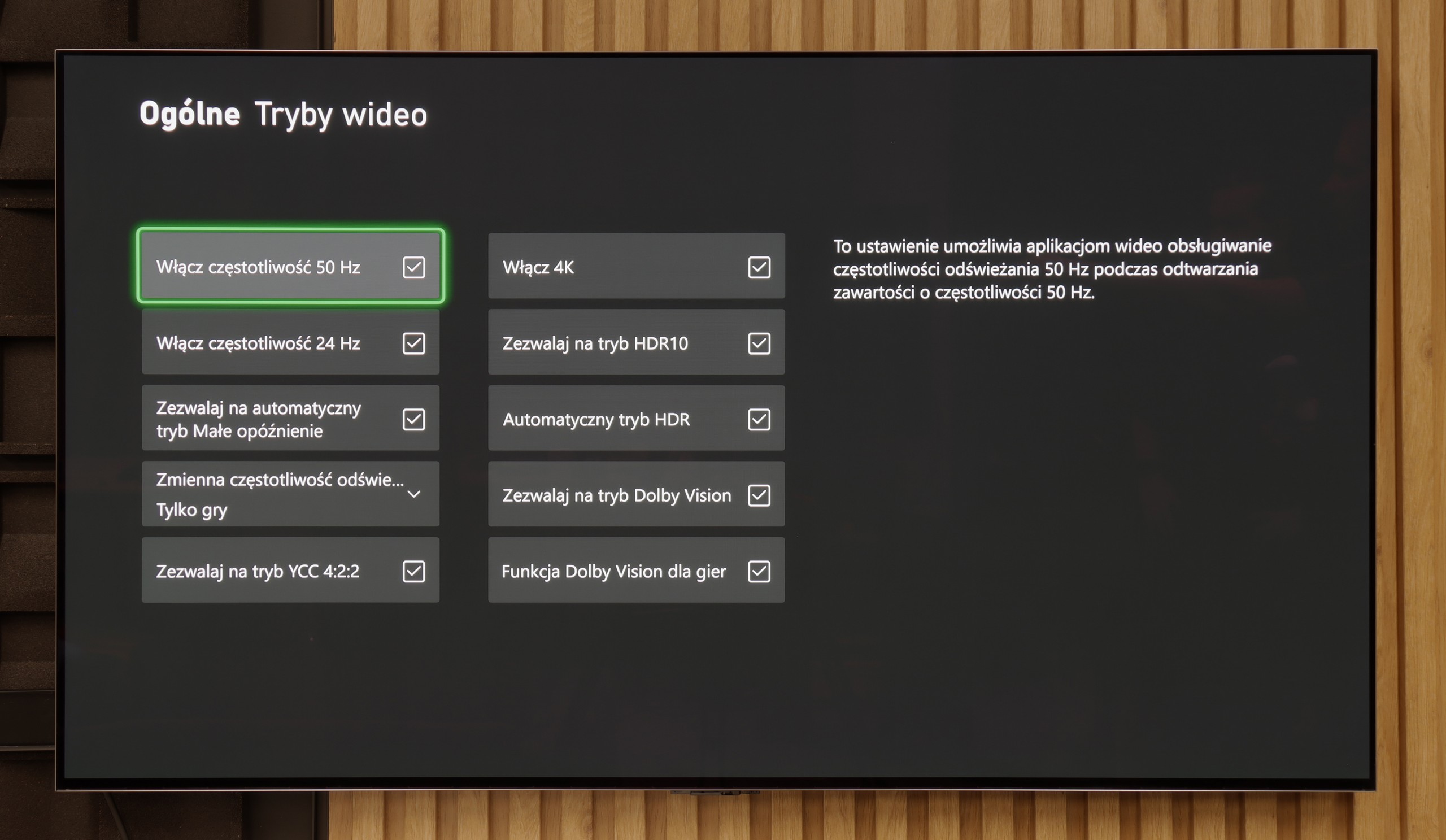

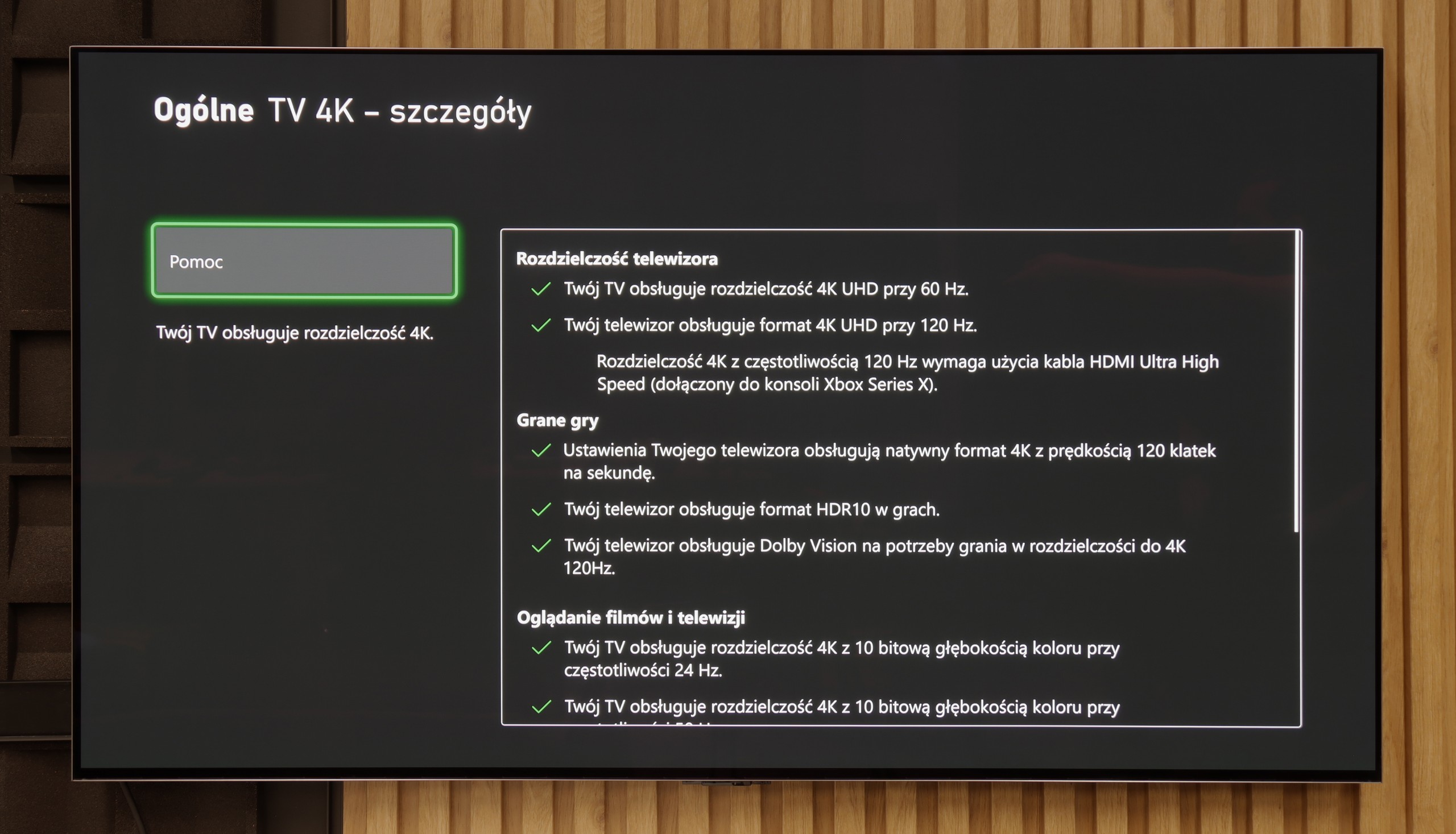

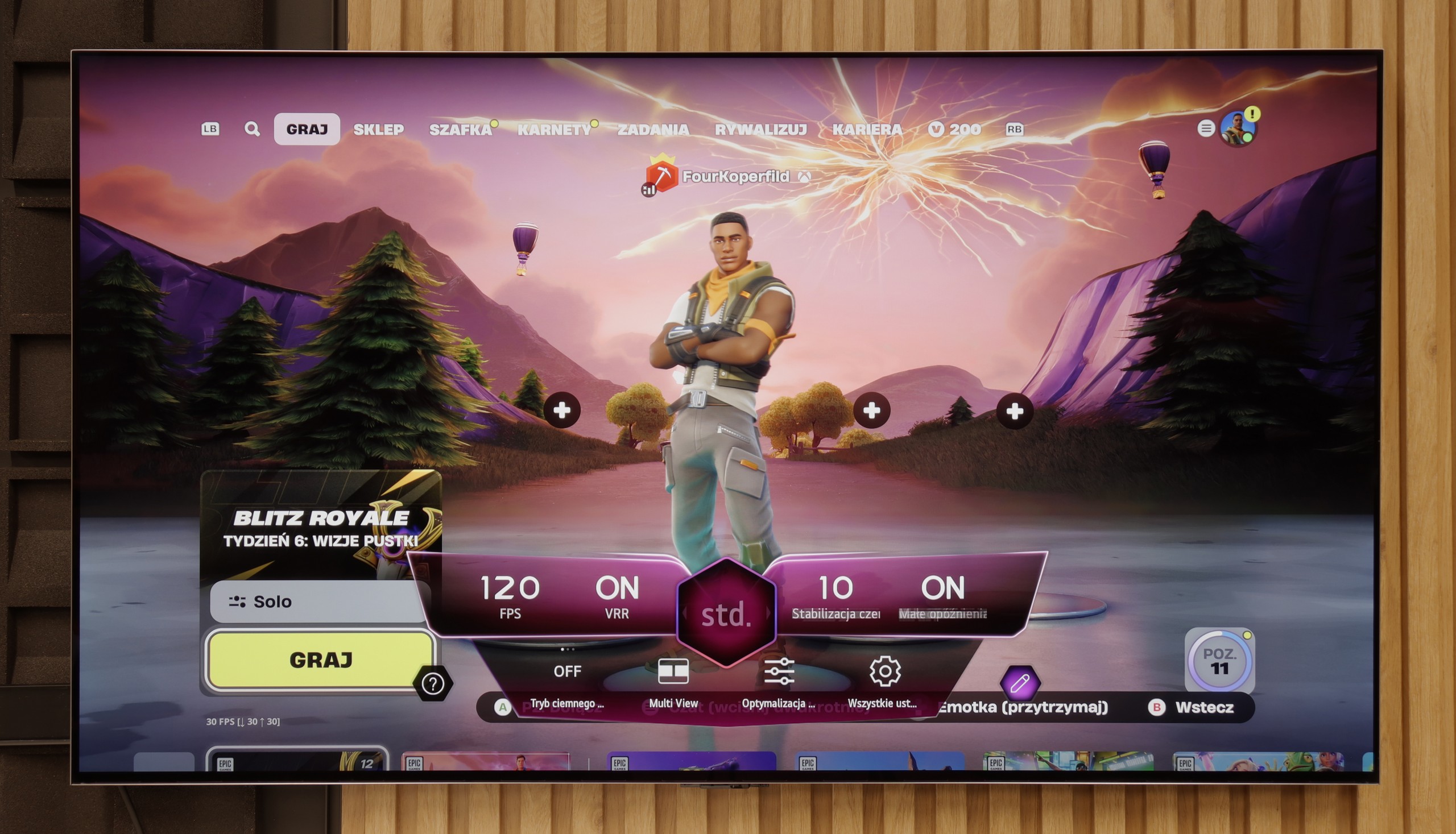

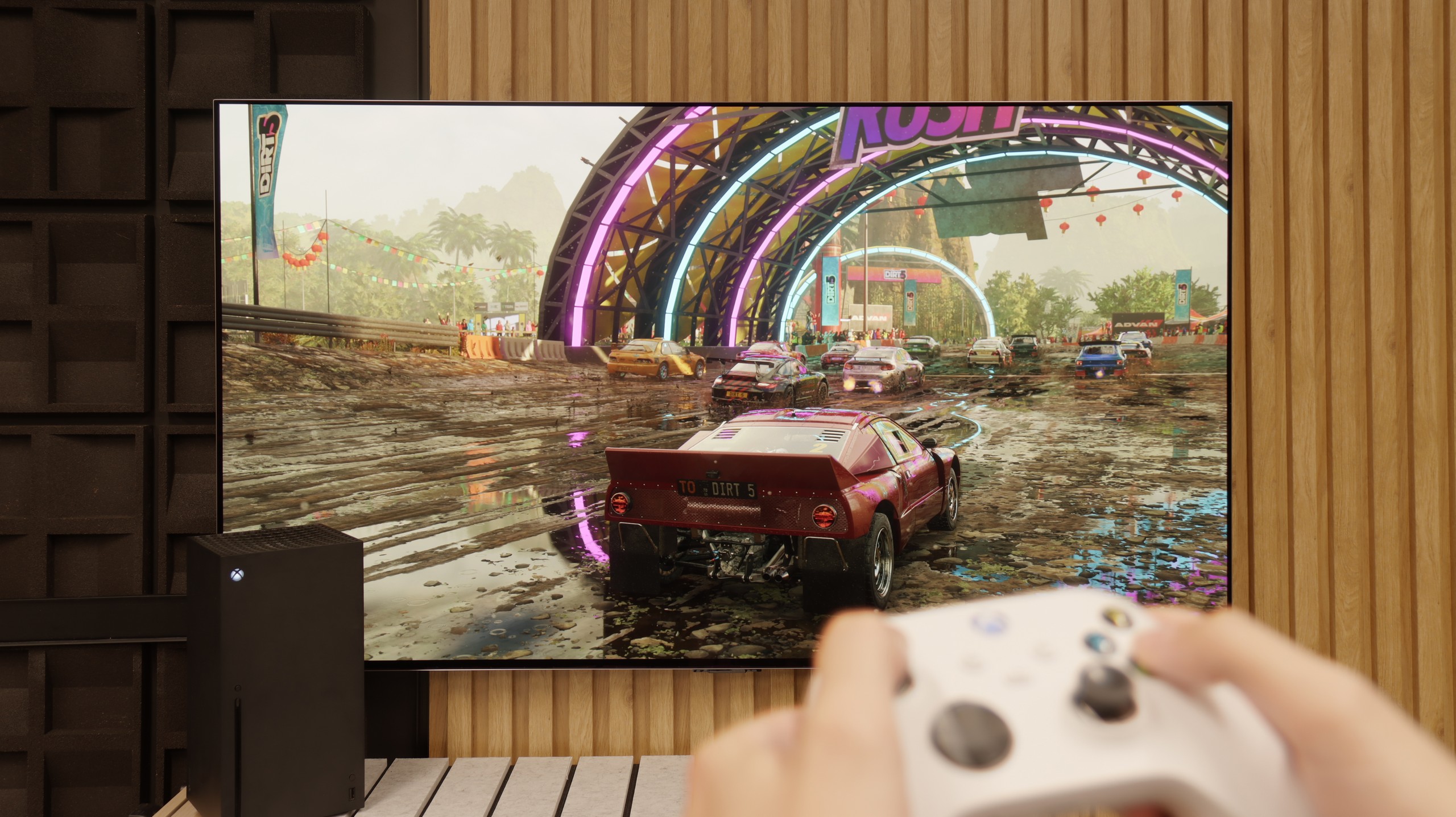
If you enjoy switching on your console and immersing yourself in games for hours, the E7NQ PRO is sure to make a strong impression. With its 144Hz refresh rate, gameplay feels impressively smooth, while support for HDMI 2.1 and VRR prevents screen tearing, even during the most action-packed moments. Additionally, ALLM automatically applies the lowest latency as soon as you switch to your console, so there’s no need to tweak the settings manually.
A major plus is the ability to play games in Dolby Vision, enhancing colours and contrast for a more vibrant experience. Hisense has also included a user-friendly game bar, allowing you to monitor key performance stats and adjust settings without leaving the game. The only real drawback is the absence of HGIG support. While not essential, some gamers may miss it if they’re looking for the most accurate representation of a game’s intended visuals. That said, in practice, the E7NQ PRO delivers an excellent gaming experience that’s smooth, responsive, and enjoyable.
Features for gamers? Perfect. That should be enough for you to know what level we are dealing with here. G5 is a television designed with gamers in mind, so we find literally everything one can expect from a gaming screen. There is Game Bar, support for high resolutions with high refresh rates – that is, 4K at 120 Hz, and even more, because the panel has a refresh rate of 165 Hz (which PC gamers will benefit from). The television supports variable refresh rates (VRR), automatic low latency mode (ALLM), and correctly supports HDR in games thanks to HGiG. All of this adds up to one of the best sets of gaming features available on the market. Well done, LG.
Input lag
9.9/10
9.9/10
SDR
HDR
Dolby Vision
In this regard, Hisense E7NQ PRO really delivers. At a frequency of 60 Hz, we measured about 15 ms, and at 120 Hz the lag drops even to 6 ms, allowing for very quick response and smooth control in games. It is also worth mentioning that even in Dolby Vision mode, input lag doesn't increase dramatically. This allows us to enjoy better image quality without having to sacrifice responsiveness, which will certainly please every avid gamer.
The input lag on the LG G5 is incredibly low. The response time to our actions – whether we're playing with a controller, keyboard, or mouse – is almost perfect. The controls are instant, and the game reacts exactly when we expect it to. The Dolby Vision Gaming mode does introduce slightly higher delays, but even then it's hard to complain about anything – in the worst case, the values hover around 20 ms, which for most players will be practically unnoticeable.
Compatibility with PC
7.6/10
8.8/10

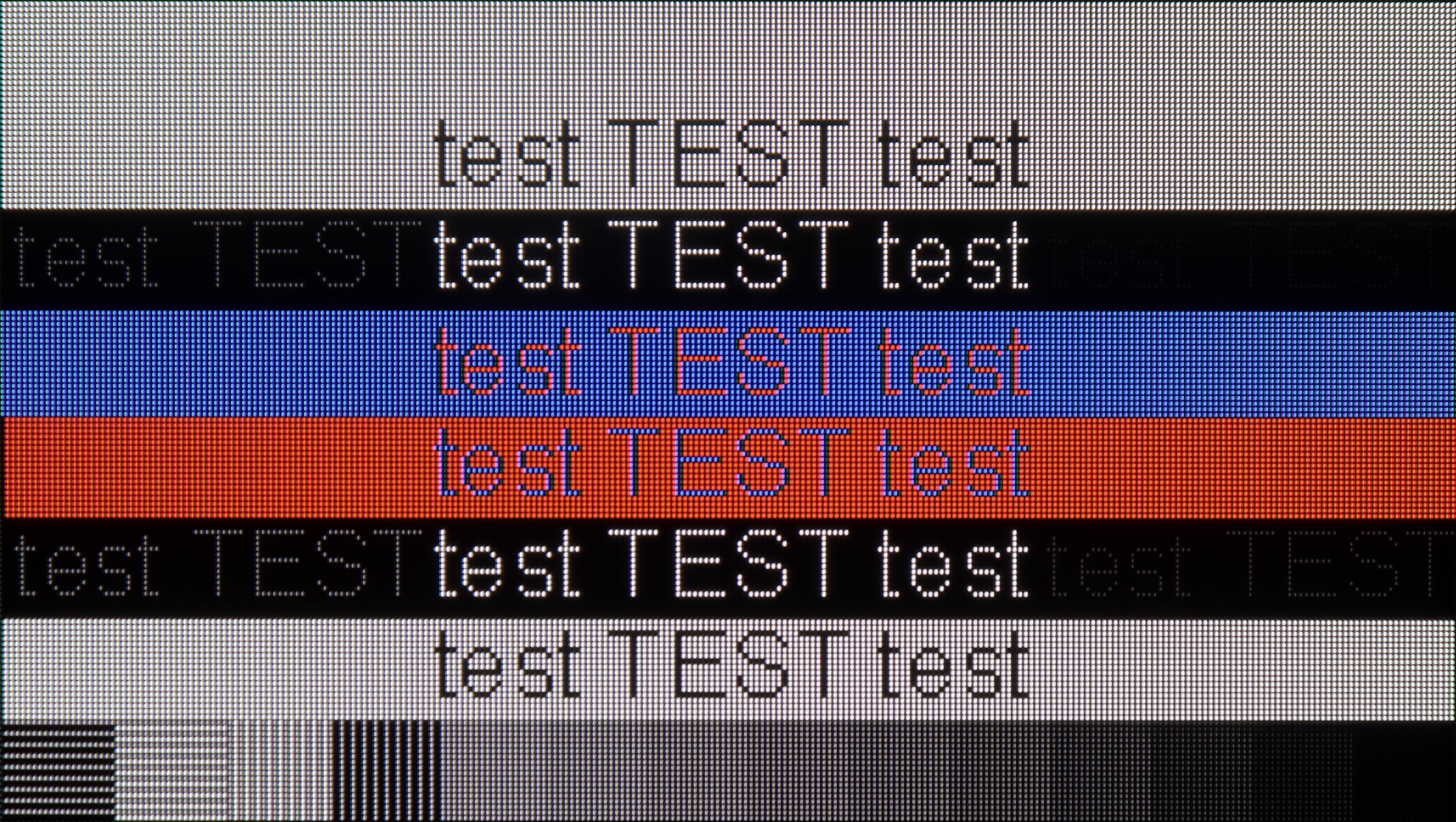
By connecting the E7NQ PRO to a computer, we will have no reason to complain. The overall readability of fonts is quite good, although with very thin, horizontal lines (the so-called "roofs" of letters) we noticed a slight dimming. This is not a big problem, but it's worth mentioning if we plan to spend long hours in text editors or browsers.
On the other hand, when it comes to gaming on PC, the TV shows its true claws. Support for G-Sync, connection with a 144 Hz panel, and low input lag make even the most demanding titles run smoothly and responsively. As a result, the screen works well not only with a console but also as a solid "window" to the world of PC entertainment.
Collaboration with a PC? Almost ideal. The television, as we mentioned earlier, has great features for gamers – including those using a PC. On board, we find full G-Sync certification, a 165 Hz panel, and a super-fast input lag of around 5 ms. Thanks to the correct implementation of chroma 4:4:4, fonts are very readable – both the smallest and the largest. Although due to the WRGB subpixel layout, there may be slight shadows around the characters, for most users this effect will be virtually unnoticeable. The G5 performs excellently as a screen for work, entertainment, and gaming – also from a computer.
Viewing angles
6.5/10
7.5/10
In the case of Hisense E7NQ PRO, viewing angles are definitely a strong point, thanks to the IPS panel. This means that when we look at the screen even from a significant angle, colours and brightness do not "shift" as much as in TVs with a VA panel. Of course, compared to OLED or QD-OLED screens, where the image remains practically unchanged from any side, IPS still appears modest. Nevertheless, among LCD televisions, it is hard to find a solution that guarantees equally good viewing angles as those offered by IPS. Unfortunately, everything comes at a cost – in this case, one has to live with average black levels and lower contrast.
The viewing angles on the LG G5 are very good, mainly due to the use of the WOLED matrix. It's hard to find something to complain about here – the image does not significantly lose brightness or quality even when we look at the screen from the side. However, it must be fairly noted that there is some regression compared to the G4 model. The predecessor used an MLA matrix with micro-lenses, which offered slightly better light distribution. Also, compared to QD-OLED matrices, the angles are worse. Nevertheless, the overall viewing experience at an angle remains very good and should not be an issue in everyday use.
TV efficiency during daytime
6.2/10
8/10

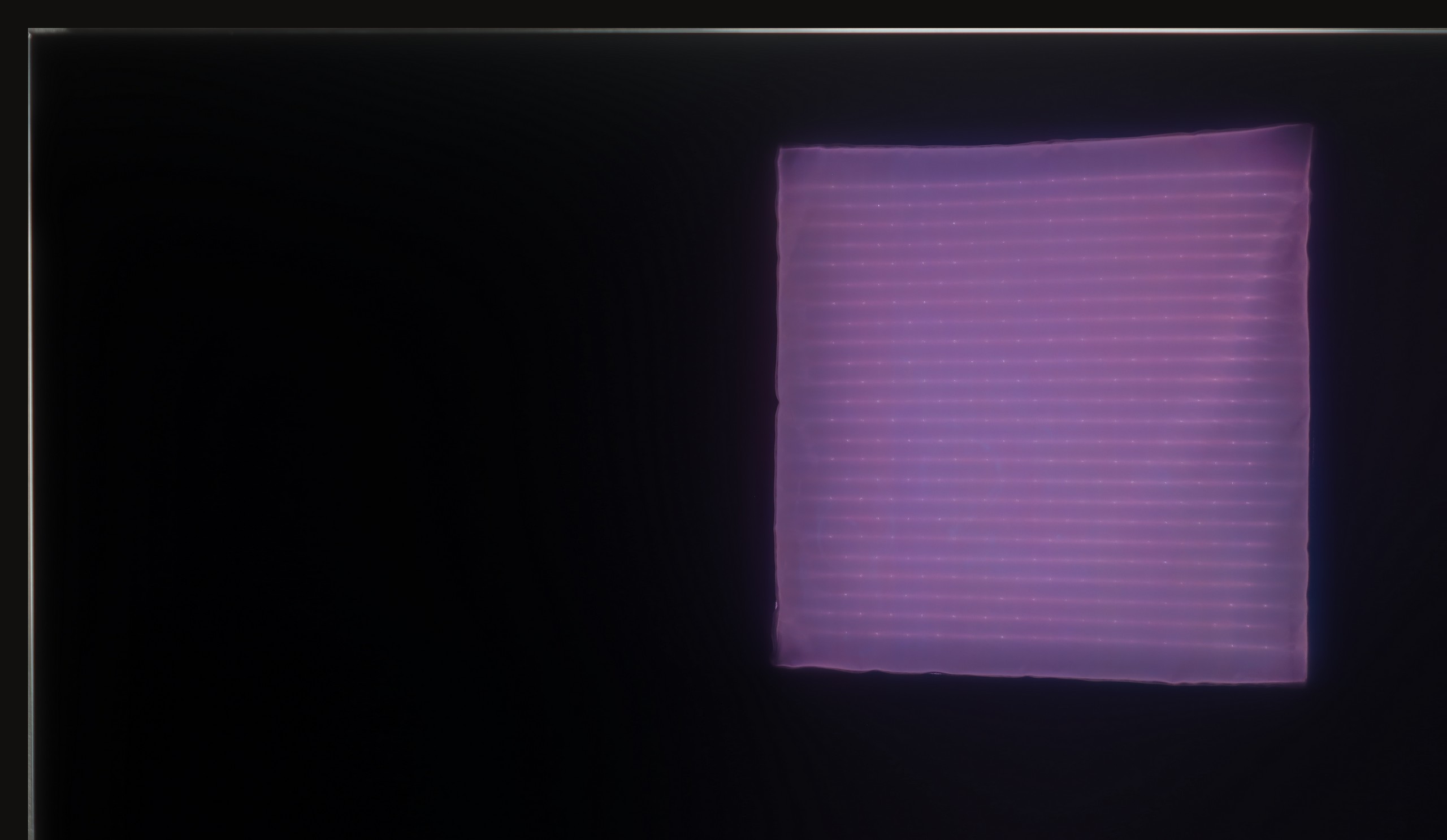


Matrix brightness
Average luminance SDR
LG OLED G5: 810 cd/m2
Hisense E7NQ PRO: 478 cd/m2
On a bright day, E7NQ PRO performs quite well. The "satin" matrix diffuses light well, which prevents reflections and glare from turning into distracting "spots" on the screen. With an average brightness of around 500 cd/m², it is possible to watch television in a sunlit room without much struggle to see details or clear content. While it may not be at the level of the highest premium models, it still proves to be quite decent in everyday use.
The LG G5, thanks to its very high brightness, performs excellently in bright rooms. Even with SDR content, the average brightness value is around 800 nits, which is significantly more than in standard televisions. It can easily handle a bright living room. Although the panel averages out reflections, it still maintains significantly better black levels and colors during the day than QD-OLED panels or matte-coated screens. The G5 will perform well in very sunny rooms—unless you really can't stand reflections on the screen. In that case, you will need to use blackout shades or consider buying a television with a matte screen.
Details about the matrix
Subpixel Structure:

Panel uniformity and thermal imaging:


TV features
8.9/10
8.5/10
- HDMI inputs2 x HDMI 2.0, 2 x HDMI 2.1 48Gbps0 x HDMI 2.0, 4 x HDMI 2.1 48Gbps
- Other inputsRCA (Chinch)IR (remote)
- OutputsToslink (Optical audio), eARC (HDMI), ARC (HDMI), Mini-Jack (Headphones)Toslink (Optical audio), eARC (HDMI), ARC (HDMI)
- Network InterfacesWi-Fi 2.4GHz, Wi-Fi 5GHz, Ethernet (LAN) 100MbpsWi-Fi 2.4GHz, Wi-Fi 5GHz, Ethernet (LAN) 100Mbps
- TV receptionDVB-T, DVB-T2, DVB-S, DVB-S2, DVB-CDVB-T, DVB-T2, DVB-S, DVB-S2, DVB-C
Classic features:
- Recording to USB (terrestrial TV)
- Recording programming
- Picture in Picture (PiP)
- RF remote control (no need to aim at the screen)
- Backlit remote control
- Teletext
- Audio only mode
- Bluetooth headphones support
- Simultaneous Bluetooth headphones & TV audio
Smart features:
- AirPlay
- Screen mirroring (Windows Miracast)
- Voice search
- Voice search in native language
- Ability to connect a keyboard and mouse


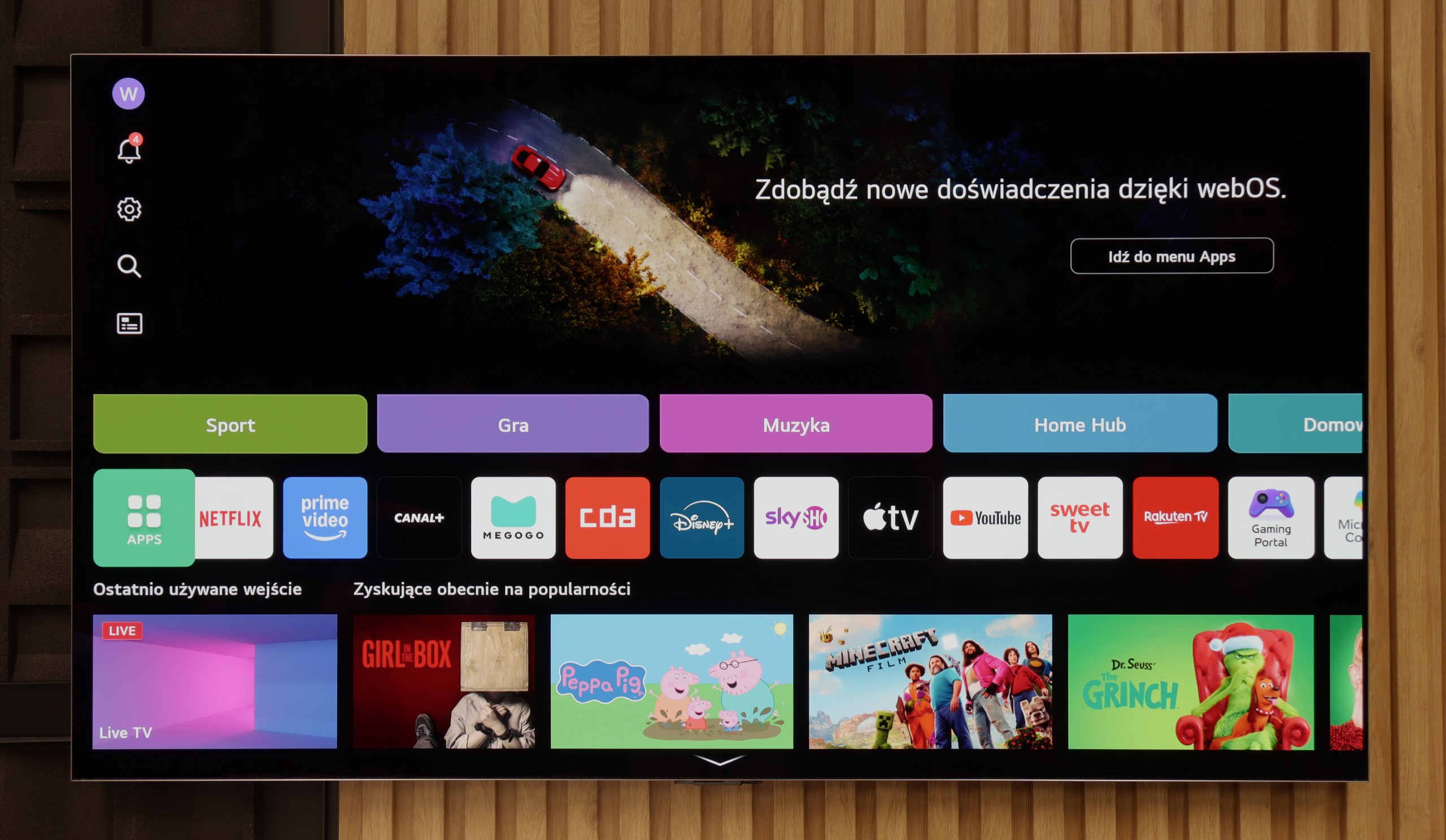
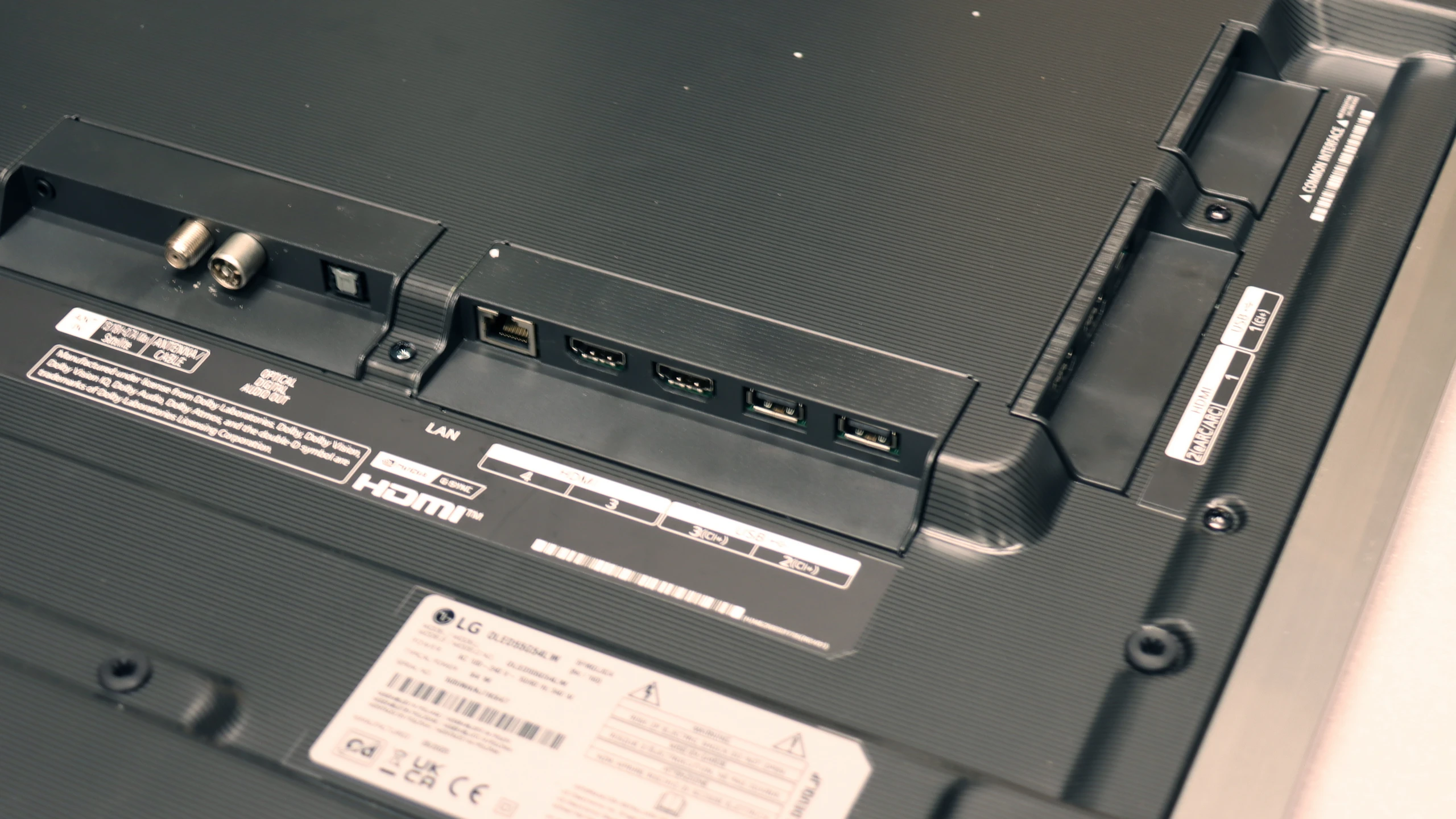
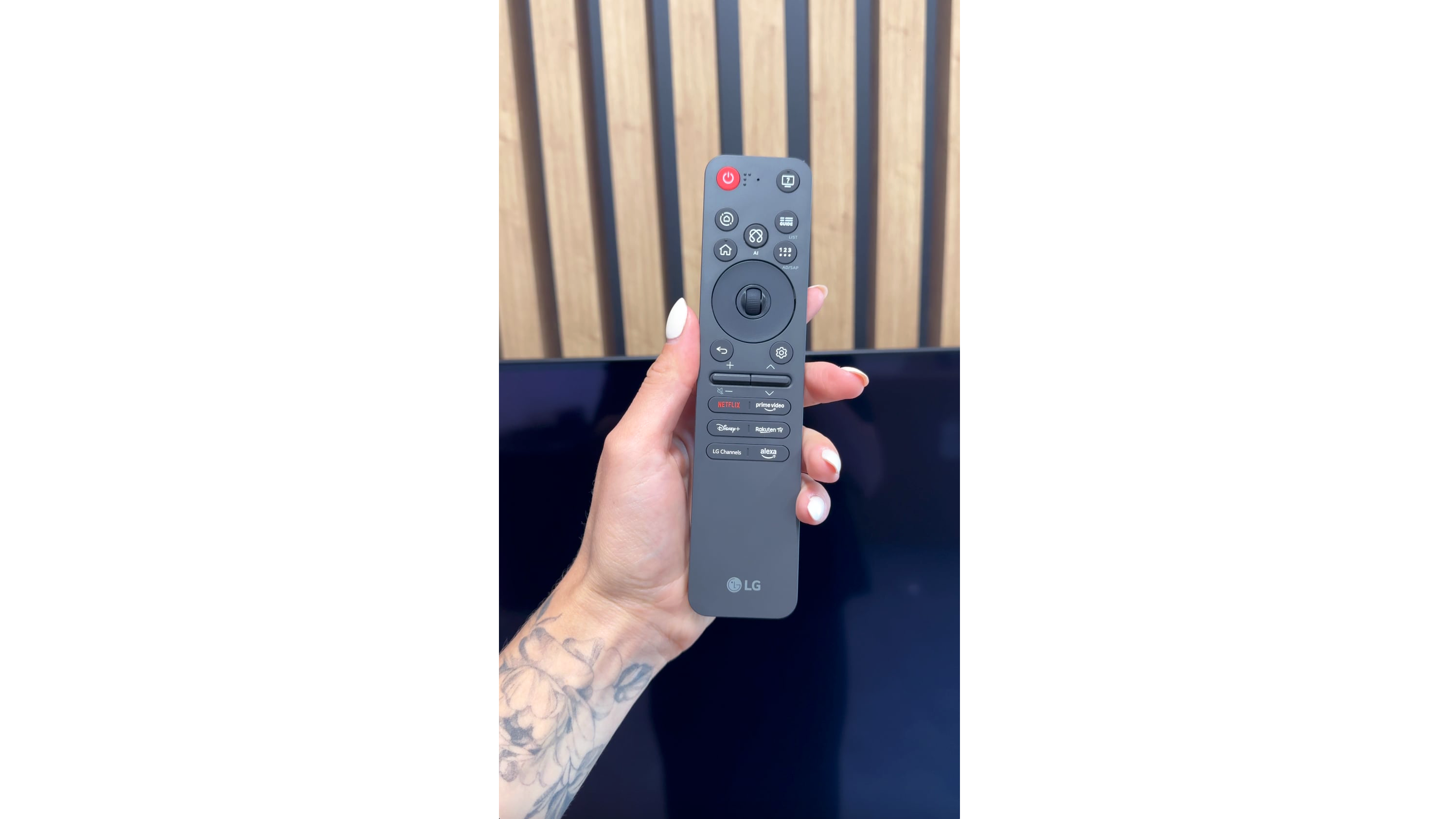
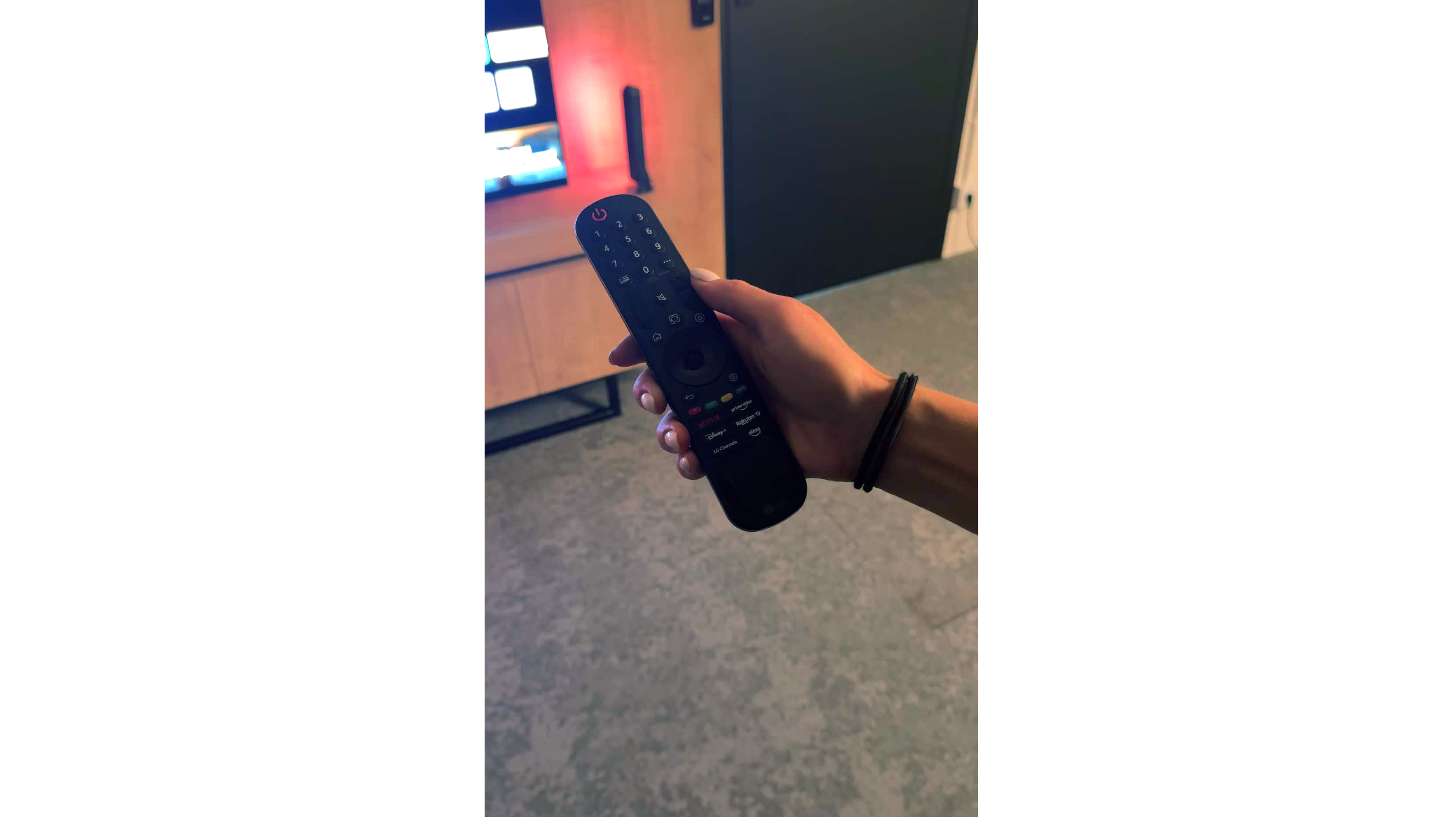
Hisense E7NQ PRO operates based on the VIDAA system, which has recently made significant progress. Here we find most popular applications, although, some music platforms, such as Spotify and Tidal, are missing. Nevertheless, navigating the menu is quite pleasant, and responsiveness is satisfactory. Yes, there are occasional minor "stutters," but not something that will overwhelm our daily usage experience.
On the positive side, we can count on the support for voice search, which makes it easier to find your favourite content without the tedious task of typing letter by letter. The TV also offers a lot of additional options: we can record programs, use AirPlay and mirroring, and also enjoy extensive wireless connectivity options (Wi-Fi and Bluetooth). It may lack a backlit remote or Picture-in-Picture (PiP) mode, but these are rather niche functions, so few people will truly feel their absence. In everyday use, we simply have a solid base of useful tools and convenient solutions.
Classic Features
LG G5 has a lot to offer when it comes to classic TV features. Aside from the lack of the ability to watch two sources (PIP), the television performs well for everyday use. There are no issues with connecting external Bluetooth devices, such as headphones, and the EPG interface is very clear and understandable – even for those who are not particularly tech-savvy.
Smart TV Features
The Smart TV in the G5 operates on the WebOS system – it is the heart and brain of the entire television. Thanks to the Magic remote, using the G5 is truly enjoyable. We control the cursor on the screen with wrist movements, which is somewhat reminiscent of using a mouse in the air. The system itself is very comprehensive and offers everything one could expect: AirPlay, screen mirroring, voice search, and voice commands – all of these work smoothly and without delays. Without a doubt, this is one of the best operating systems in televisions on the market.
Note:
During our testing, we had practically nothing to complain about – except for one exception: the confusion surrounding the remote. Depending on the market and the specific version of the model, you may come across the new, minimalist Magic remote (without a numeric keypad), or the older version with a full set of buttons. We tested the G54LW model, which had the new Magic remote, but it is hard to say how the situation looks in other variants. Perhaps it is a similar situation to the LG C5 series, where the addition of the remote also depends on the specific market.
Playing files from USB
5.2/10
9/10
Supported photo formats:
Maximum photo resolution:

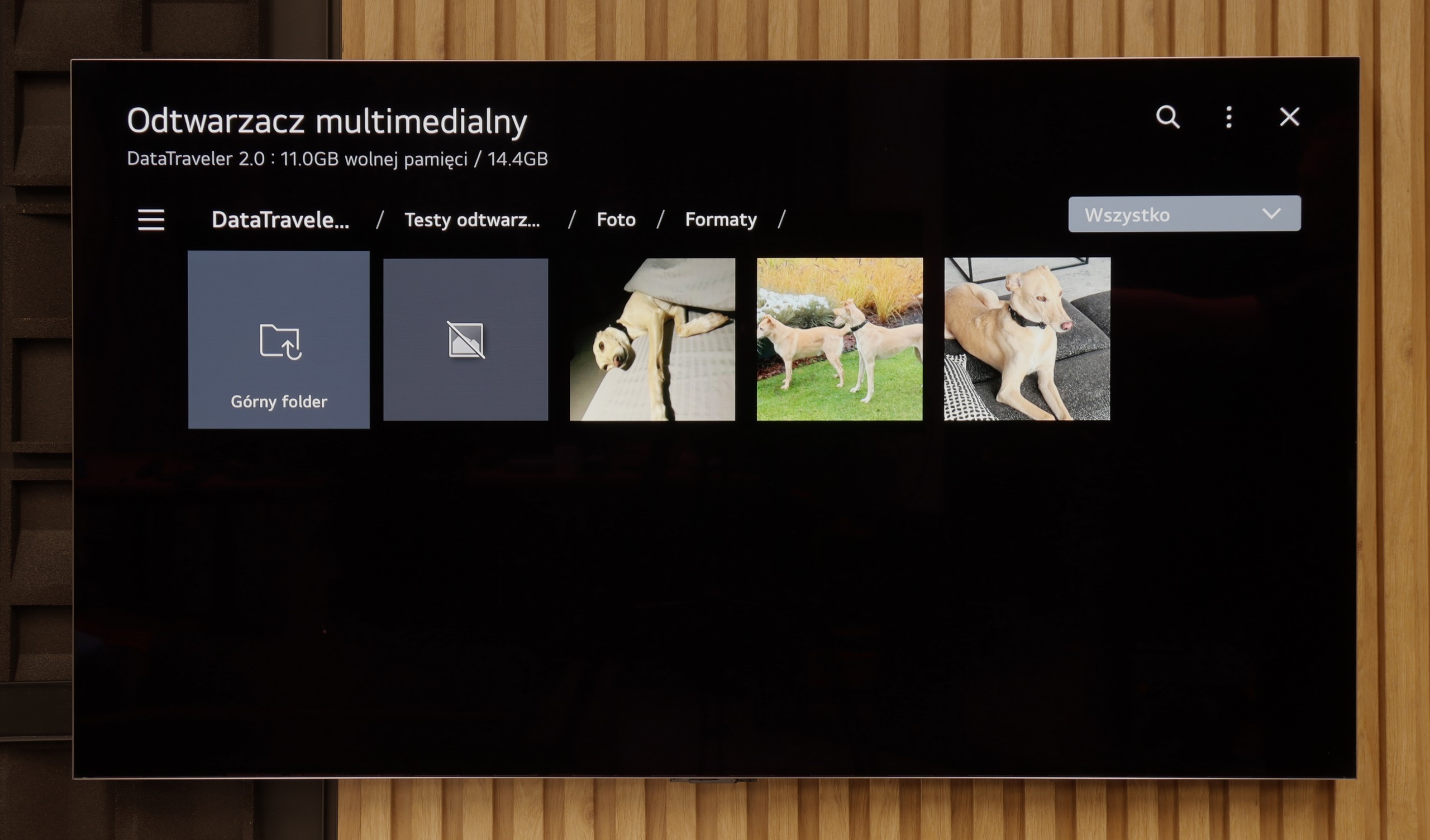
If you are counting on comfortable movie watching with subtitles straight from a pendrive, you may, unfortunately, be disappointed. Just like with the previously tested A7NQ, here we encounter a rather peculiar situation: the television does not display subtitles, even if we correctly load them onto the device and try various formats. Paradoxically, we find options to change the colour and appearance of the font, but as they say – what’s the point if we still can’t see anything?
In the case of other files, such as photos or music, the E7NQ PRO manages just fine, playing the most popular formats without a hitch. Unfortunately, for those who would like to use the television as a multimedia player, the lack of working subtitles is quite a major inconvenience.
The built-in media player in the LG G5 is really very good. It supports virtually everything you would expect from a modern television – most popular formats work without issue, and the application performs quickly. Our only disappointment was the lack of support for very high bitrate HEVC files at 85 Mbit/s – similar to the C5 and B5 models. Interestingly, the same file worked flawlessly on last year's LG OLEDs, so it's hard to say what is behind this change. Nevertheless, in everyday use, the G5 will handle the vast majority of content, and there will be no need to connect any external devices for media playback.
Apps
7.7/10
9.1/10














































Sound
7/10
8.7/10
- Maximum volume--
- Dolby Digital Plus 7.1
- Dolby True HD 7.1
- Dolby Atmos in Dolby Digital Plus (JOC)
- Dolby Atmos in Dolby True HD
- DTS:X in DTS-HD MA
- DTS-HD Master Audio
When it comes to the built-in speakers, Hisense E7NQ PRO pleasantly surprised us. Of course, it's not on the level of a decent soundbar or home theatre system, but it performs quite well in everyday conditions. During our tests, dialogues remained clear, and the sound was sufficiently clean and spacious that there was no immediate need to invest in additional speakers.
It's also worth mentioning the support for many audio formats – from Dolby Atmos to the less common DTS:X. This means that if we come across suitable source materials, we can expect a more immersive and spatial experience. Although in terms of sound it still mainly serves as a decent base, Hisense E7NQ PRO should satisfy most users who want to turn on the TV and hear clear, unbothered sound.
The sound on the LG G5, given its slim body, is truly phenomenal. When listening to music, a light, pleasant bass can be felt, and in movies, the dialogues are clear and easily heard – they do not get lost even in dynamic scenes. Unfortunately, a certain disappointment is the lack of support for the DTS format, which LG used in its older models. It's a shame, because many people with home theaters may see this as a step backward.


